Glass furnaces are high-temperature working bodies. The refractory materials in various parts are affected by gas (smoke), liquid (glass liquid) and high temperature respectively. The erosion rate is uneven. Often, damage to a certain part will reduce the service life of the entire glass furnace. Although local hot repair can appropriately extend the service life of the glass furnace, in fact, hot repair of certain parts is quite difficult.
Therefore, it is necessary to select different refractory materials according to the erosion mechanism and speed of different parts of the glass furnace to increase the service life of the glass furnace.
This article will focus on the refractory material selection and structural improvement of vulnerable parts from the melting part of the glass furnace.
ⅠCrown
The erosion of the crown causes local holes or collapse.
►The causes of damage include:
• normal wear and tear;
• flame impact, mainly the crown in the melting part;
• erosion of batch dust, mainly the crown near the doghouse;
• upward drilling erosion caused by excessive glass furnace pressure, etc.
Insulating the crown accelerates the above erosion, because the outer surface temperature of the crown is generally between 240 and 360℃ when it is not insulated,
and the outer surface temperature of the crown rises to about 680 to 1280℃ after the crown is insulated.
►At present, the material used for the crown is high-quality silica bricks.
• First, the load softening temperature of silica bricks is relatively high, about 1650℃;
• Second, the products of silica bricks after erosion are soluble in glass liquid, and the reaction products will not cause changes in the composition of glass liquid after falling into the glass liquid. In order to further improve the service life of the crown and improve the heat exchange in the flame space, the silica bricks used in the crown can be honeycombed into a honeycomb crown top.
►The advantages of using a honeycomb crown are that it can:
• Increase the effective heat transfer from the heated surface of the crown to the molten zone,
• Reduce the temperature of the non-heated surface of the crown,
• Eliminate the crown drops generated during high-temperature operation,
• Reduce the erosion of the high-temperature crown on the crown foot bricks and breast wall,
• Eliminate the phenomenon of the crown bricks being inverted during the construction of the crown,
• Reduce the falling corners of the crown bricks during the furnace heating process,
• Reduce and avoid the scouring of the crown by the flame due to the stagnant gas in the honeycomb.
►In addition, in order to increase the service life of the crown, the volume of the flame space can be increased.
The size of the flame space volume is measured by the flame space heat load value. The flame space heat load value in foreign countries is generally between (5~6) ×104kcal/m3·h, while the heat load value of the same type of glass furnace in China is generally between (9~12) ×104kcal/m3·h. Increasing the volume of the flame space can not only ensure the complete combustion of the fuel, but also create a layer of lower temperature gas between the flame and the crown to protect the crown from the impact of high temperature.
►The method of increasing the volume of the flame space is:
• First, expand the width of the flame space.
The width of the flame space of foreign glass furnaces is generally about 500mm wider than the furnace pool, while the width of the flame space of Chinese glass furnaces is generally 200-300mm wider than the furnace pool;
• Second, increase the height of the breast wall.
The breast wall height of foreign oil-fired glass furnaces is generally 800-1000mm, while the breast wall height of the same type of furnaces in China is generally 650-750mm, and the breast wall height of some glass furnaces is still below 650mm.
When the glass furnace body is well insulated, expanding the volume of the flame space has little effect on the heat loss of this part. On the contrary, since the fuel is completely burned, the combustion efficiency of the fuel in the flame space is improved, avoiding the heat loss of incomplete combustion of the fuel, and achieving the purpose of energy saving.
The vulnerable parts of the doghouse are the doghouse arch and the doghouse corner blocks.
►The causes of damage include:
The doghouse arch is easily damaged by the erosion of flames and the erosion of the mixed material dust.
Fused cast zirconium corundum blocks (Fused cast AZS blocks) should be used.
The doghouse corner blocks are damaged quickly by the high temperature, chemical erosion of glass liquid and mixed materials, and the thrust of the charging machine.
►Fused cast AZS blocks without shrinkage holes(WS) should be used.
At the same time, the corner blocks should be designed or processed into round or hexagonal shapes to reduce resistance and increase the service life of the corner blocks.
The thickness of the corner blocks should be about 30% greater than the thickness of the sidewall blocks to increase the weight of the blocks prevents them from moving during heating and charging, which may cause leakage.
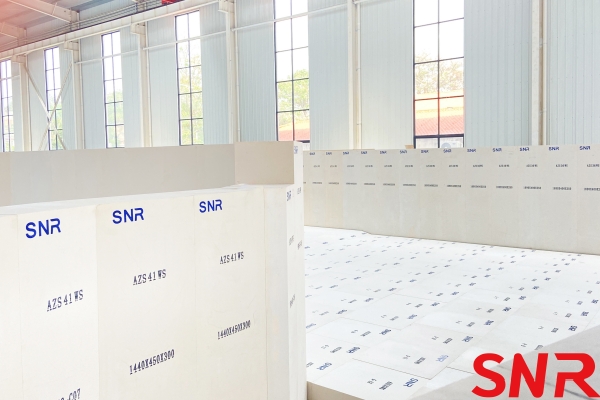

The erosion of the sidewall near the glass liquid surface line is caused by mechanical scouring of the glass liquid flow, erosion by combustion products, upward erosion caused by the reaction of glass liquid and refractory materials, etc.
►The causes of damage include:
Erosion occurs at the three-phase interface of gas, refractory materials and glass liquid.
The result of erosion eventually causes the destruction of the cubic lattice of the sidewall blocks, causing glass liquid leakage. If there are horizontal block joints in the side wall, the erosion rate of the side wall blocks will be accelerated due to the upward erosion in the horizontal block joints.
Therefore, it is advisable to place the entire fused cast AZS block vertically, eliminate the horizontal block joints, and slow down the erosion rate of the side wall.
►In addition, the upper part of the side wall is made inclined:
which is conducive to delaying the erosion of the refractory materials at the three-phase interface. This is because the bubbles generated in the reaction of glass and refractory materials rise along the inclined surface and are discharged, reducing the effect of "upward drilling erosion". At the same time, because the side wall near the glass liquid surface line is correspondingly thinned, it is conducive to the cooling wind to achieve the best cooling effect.
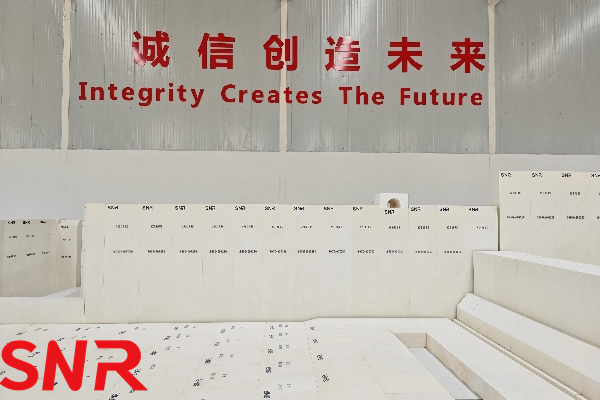

Ⅳ Tank bottom
The tank bottom is in contact with the glass liquid, and the refractory material used is generally large clay bricks.
►The causes of damage include:
When the glass furnace adopts full insulation and bubbling technology, the temperature of the glass liquid near the tank bottom is higher and the flow speed is higher. The erosion of the tank bottom is mainly caused by mechanical scouring of the glass liquid, metal drilling erosion, and the reaction of the glass liquid with refractory materials.
►Structural improvement:
Therefore, the large clay bricks at the tank bottom are damaged quickly, and it is difficult to hot repair this part. The damage of the tank bottom directly affects the service life of the glass furnace. In order to improve the anti-erosion ability of the tank bottom, a layer of 5mm thick zirconium ramming material is laid on the surface of the clay brick in contact with the glass liquid to act as a seal, and then a layer of 65mm thick AZS blocks is laid on the upper part of the ramming material. The tank bottom treated in this way can be used for several furnace periods.
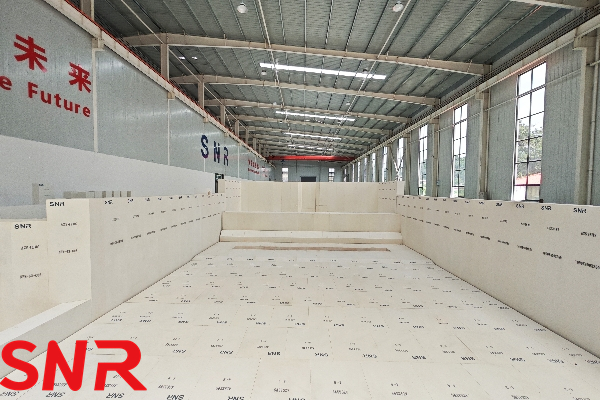

Ⅴ Throat
The throat is the passage for the glass liquid between the melting zone and the cooling zone of the glass furnace.
The throat blocks are made of AZS blocks containing 41% ZrO2 without shrinkage cavities (Fused cast AZS 41# WS blocks), which can reduce the erosion rate of the throat to the minimum. However, due to the high temperature and high flow rate of the glass liquid and the circulation at the inlet, mechanical scouring and upward erosion are very likely to occur.
►The causes of damage include:
The main erosion parts are the throat cover blocks, which are facing the inlet of the melting zone and the outlet of the working zone. In order to reduce upward erosion, the horizontal block joints should be minimized when arranging the throat blocks. The block arrangement methods of throat with different immersion depths.
In addition, in order to further improve the service life of the throat and improve the uniformity of the glass liquid flowing through the throat, the throat can be gradually tilted upward from the melting zone inlet to the cooling zone outlet, which can prevent the throat cover block from being corroded too quickly and reduce the reflux of the glass liquid in the throat. The tilt angle is generally 15-20°. It is found from practice that the upward-inclined throat can make the bubbles overflow along the inclined direction, prevent upward erosion, and extend the service life of the throat.
The upward-inclined throat matched with a shallow working tank can:
• reduce the stratification of the glass liquid, prevent reflux,
• make the glass liquid temperature uniform,
• reduce the stripe defects of the glass products.
When using an inclined throat, the blocks must be specially ground, polished, and pre-assembled to avoid glass liquid leakage.

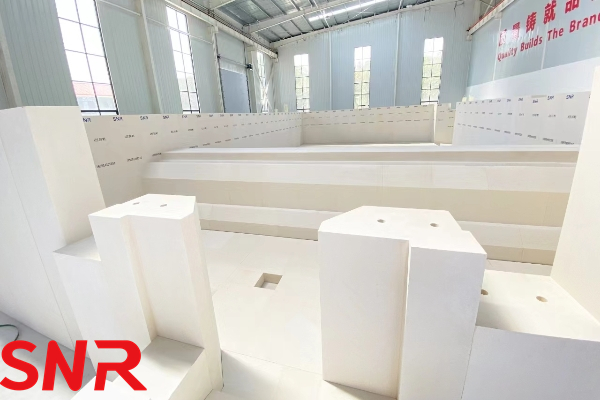
To sum up, the glass furnace is the core equipment in the glass production process. The refractory material selection and structural improvement of its vulnerable parts are crucial to extending the service life of the glass furnace and ensuring production efficiency and product quality. Through detailed analysis and improvement of key parts such as the crown, the doghouse, near the liquid level line, the bottom of the tank, and the throat, we can not only significantly improve the high temperature resistance and corrosion resistance of the glass furnace, but also effectively reduce the cost of the glass furnace. The failure rate of the glass furnace during operation ensures the continuity and stability of glass production.
In terms of specific refractory material selection, refractory materials with high melting point, high strength, good thermal shock resistance and chemical stability should be reasonably selected based on the actual working environment and stress conditions of each part. At the same time, the durability of glass furnace components can be further improved by optimizing structural design, such as increasing structural strength, improving heat dissipation conditions, reducing stress concentration, etc.
In addition, with the continuous advancement of science and technology and the continuous emergence of new materials, we should continue to pay attention to and introduce advanced refractory materials and furnace technology to provide more possibilities for refractory material selection and structural improvement of glass furnaces. Through continuous exploration and practice, we can promote the sustainable development of glass furnace technology and provide strong support for the transformation, upgrading and high-quality development of the glass industry.
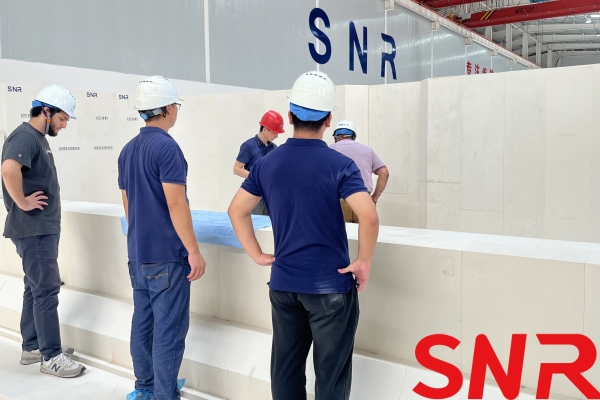

Henan SNR Refractory Co., Ltd. has been specializing in the production of fused cast AZS blocks for about 25 years. We use high-quality raw materials and advanced fusion technology to provide customers with high-quality products. From raw material procurement to finished product delivery, every step is strictly quality inspected to ensure that every indicator meets the standards, so you can use it with confidence.
 If you have any needs, you can contact me at any time.
If you have any needs, you can contact me at any time.
 Web:www.snr-azs.com
Web:www.snr-azs.com
 Email:wendy@snrefractory.com
Email:wendy@snrefractory.com


